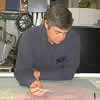| |
NeMO Overview - Ed Baker, Chief Scientist Wecoma/CTD Cruise
 RV
Wecoma, NeMO 2001 cruise summary RV
Wecoma, NeMO 2001 cruise summary
Ed Baker, Chief Scientist
The NeMO
2001 Water Column cruise fulfilled its mission of monitoring hydrothermal
activity along the Juan de Fuca Ridge, obtaining data and samples from
three separate geologic areas. Our principal focus, of course, was Axial
Volcano, site of the NeMO Observatory. Our cruise this year was the fifth
since the eruption of January 1998 reinvigorated hydrothermal venting
along the southeast border of the caldera. The previous four cruises have
documented first an enormous expansion of hydrothermal activity coincident
with the eruption, followed by a rapid decline as the dike that fed the
eruption began to cool. We have also monitored changes in the chemistry
of the discharge fluids, changes that may be related to changes in the
microbial population within the crust. This year's results indicate that
hydrothermal activity here continues to wane. We conducted eight "tow-yo"
and 26 vertical CTD casts in and around the caldera, collecting hundreds
of water samples in the process. These data will be used to produce maps
of the distribution and composition of hydrothermal plumes presently overlaying
the summit of Axial Volcano. When combined with previous years' data we
will be able to summarize the natural history of venting here since the
eruption, and improve our understanding of the effects of seafloor eruptions
on the chemistry and biology of the deep sea.
We also contributed
to the NeMO Observatory network by deploying four moorings to collect
plume data for the next 12 months. While we cannot communicate with these
moorings as we can with the primary NeMO mooring, they form a critical
part of our three-dimensional monitoring of Axial Volcano.
After our
work at Axial, we steamed south to the Cleft segment of the Juan de Fuca
Ridge. The largest know eruption on the Juan de Fuca Ridge occurred here
in 1986, and we have been monitoring its effects yearly since then. This
time-series is the longest of any vent site on the ocean floor. It provides
our only opportunity to observe slow changes in hydrothermal activity
that may have time scales of 10 or 20 years. Knowing the pace of these
long-term changes is necessary to accurately interpret shorter-term changes
that are more commonly seen. At Cleft we conducted six tow-yos and eight
vertical casts, at sites we have regularly occupied for several years.
Our final
site was an unusual one in the Blanco Fracture Zone, which connects the
Juan de Fuca Ridge with the Gorda Ridge to the south. Fracture zones do
not normally host hydrothermal activity, since they mark where the Earth's
tectonic plates slide past one another, not where they separate and allow
new magma to well up to the seafloor. Several small "pull-apart"
basins along the BFZ, however, are thought to be sites of volcanic activity.
We have evidence of a seafloor eruption in the East Blanco Depression
in 1994, and have been sampling there since then.
One of the
most enjoyable aspects of the NeMO work is the opportunity to share our
research with students, educators, and the public. We hope the NeMO website
has been an informative and enjoyable experience for everyone who has
logged on. Our cruise was aided immeasurably by the enthusiasm and hard
work of the three students and high-school teacher who joined us. Peter
McAuliffe and Angela Opiola, recent graduates of Carlton College and DePaul
University, respectively, and David Farr, a junior at Ballard High School
in Seattle, all saw oceanography from the inside and learned the rigors
and excitement of field work first hand. Missy Holzer, a science teacher
from Chatham HS in New Jersey, pitched in to help with the data collection
and spent hours writing her logbook to explain our work to the web world.
All of us in the Vents Program hope you will follow our progress in building
the NeMO Observatory in the coming years.
Thanks for
logging on, and look for us next year!
|
|

